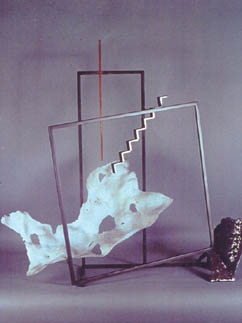The science of sculpture
The "Sculptural Bell" is a testimony to Masatoyo Kishi's education in physics and mathematics. "As a Japanese artist int he 1905s in Tokoyo, I didn't go to art school," says Kishi. "Japanese artists studied literature, economics, science; then you explored art." After his education at Tokoyo University of Science, Kishi turned to abstract expressionist painting. In the 1970s, he moved to sculpture.
Kishi's sculptures, created from steel, rusted pipe and fiberglass, are strikingly thoughtful equations of balance and intrinsic geometry. The works explore shape, planes and refraction, each presenting its own problem, each accurately answered with form, subtle color and contrasting texture.
The most intriguing works, "A-2-00 Stairs Series" and "K-1-99 Stairs Series" suspend fragile pieces of fiberglass in steel landscapes. The fiber-glass is paper-thin and resembles pieces of bone, an ingenious complement to the steel. Kishi worked with fiberglass before turning to metal for his sculpture. In these works, he says, the fiberglass suggests the human form, and the delicate pieces impart human frailty amid their metal trappings. These two works and many of of his other works include surreal metal stairs rising out of the sculptures. Kishi notes that many of his sculptures were created from memories of the World War II destruction of Tokyo.
"Many of the forms are metaphors for destruction, but the stairs are a sympbol of hope rising out the ruins," he says.
Kishi's larger works take on ambitious combinations that make the asymmetrical symmetrical by bringing unlikely elements into unison. "K-1-97 Framed #3" pits rusting pipe with smooth ebony plane, vivid triangular pieces and a graceful steel line.
Kihi's colors are reminiscent of an oxidizing junkyard, but he doesn't miss an opportunity to create interesting texture by contract rusting pipe with polished and painted surfaces.
Kishi's elemental colors are also present in his paintings, but on canvas he interjects cool touches of pale blue and green. He says he works with the canvas on the floor using a wooden stick to drop paint onto the surface.
"The paint brush is a difficult extension for me," Kishi explains. "What develops from this method is an orderly conversation between me and the canvas. I respond to each change taking place."
The most successful of his paintings transfers the dept and solidity of his sculpture onto canvas. The paintings appear to progress. Some, such as "64-C-6," have Kishi's trademark elements, buth seem to be exploratory. Others, such as "Opus No. 62-901." are loose, bright and purely musical. The bold and assured paintings, "PA-5-93 White Circle" and "AP-3-93 Red Arcg," translate his wisdom of structure. Kishi works with balancing elements, and interjecting his signature hint of hot color produces a boiling point. Despite such thought-provoking touches and juxtapositions, however, Kishi says he has no particular ideas about his work.
"I display the art works, that's it. It's up to viewers to bring their ideas."
|
